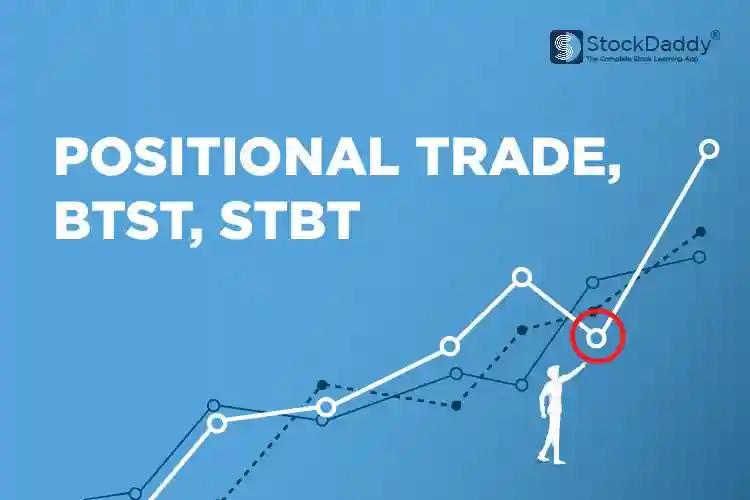Blog >
Positional trade, BTST, STBT
Positional trade, BTST, STBT

There are various categories of trading in the stock market. Each of these trading strategies fulfills different financial goals of the traders based on their views towards the financial market and the duration they wish to stay invested for. Terms such as positional trading, buy today sell tomorrow (BTST), sell today buy tomorrow (STBT), intraday trading, swing trading, etc are some prevalent trading strategies employed by traders with the hope of deriving maximum profit from market fluctuations. Broadly, these trading methods can be categorized into “Long-Term” and “Short-Term” trading strategies.
The purpose of this piece is not to acclimatize the readers with different trading forms but to explain to them 3 significant trading concepts of the stock market - Positional Trading, BTST Trading, and STBT Trading. Without any further ado, let us dive deep into these terminologies along with some demonstrative examples.
What is Positional Trading?
There is an important term in stock market trading which is positional trading. Positional trading may be worth it for you if you really want to trade in the stock market because it is a long-term trading strategy in the stock market. It is a basic trading strategy that is completely a vice-versa of intraday trading that assists you to hold your positions in the stock market for a longer period. In this, there is an advantage for you, you don’t have to be a full-time trader or spend the entire day looking at the screen like an intraday trader. Positional trading entails using technical and fundamental analysis to assess possible fluctuating market price tendencies. Few positional trading strategies help investors to grow with more benefits.
- Support and Resistance Trading
- 50-Day Moving Average Trading
- Pullback and Retracement Strategy
- Trading Breakouts
Now, you must be thinking about what are its benefits. So let’s discuss why you need to imply this trading method.
The key benefit of positional trading is that it assists you to use a variety of trading techniques. One of the significant advantages of positional trading is it makes a wonderful alternative to intraday trading, you may perform all of the tasks without spending the entire trading session riveted to the screen. It takes very little time and effort if you have a better understanding of trading strategy based on a well-researched study.
You can Learn trading and investment with the stock market course for beginners
After knowing about what positional trading is, let’s dive into BTST and STBT.
BTST stands for “Buy Today Sell Tomorrow” and STBT stands for “Sell Today Buy Tomorrow” both are playing an important role in stock marketing.
What is Open Position Trading?
Traders when they enter into a trade, be it a long or short position, their action initiate an open position trading. Open position in trading stays until the traders square off their positions. The concept has been explained with the help of an example below -
Eg: A trader buys 100 stocks of Reliance Industries. As soon as the buy order is executed, an open position is created for the trader. The position closes when the sell order of the 100 Reliance stocks is executed.
Till the time a trader is holding on to his/her open position, he/she is vulnerable to the risk arising from market fluctuations.
Some Popular Positional Trading Strategies Deployed by Successful Traders
Successful positional traders make the best use of the given strategies to maximize their profits from the shift in market momentum -
Pros and Cons of Positional Trading
Listed below are some pros and cons of positional trading that will help the readers in their decision-making -
What is BTST Trade?
“Buy Today Sell Tomorrow” makes the definition more clear to you what exactly it is. Basically, it is a short-term trading method in which a trader or an investor buys some share today, either in cash or on the f&o market, and sells it the next day. Rather than taking a long position and keeping it for a while, the trader sells the stock the next day after buying it. A BTST position is taken on stocks that are projected to trade at a higher price tomorrow as compared to the price they are trading today.
Some Popular BTST Trading Strategies Deployed by Successful Traders
- Breakout in the price movement of the security on the day of buying to be sold in the subsequent days by following T+1 settlement cycle.
- Buying before a major event expecting short-term volatility in price.
- Trade in securities that have high liquidity.
- Profit booking at 1 point less than the original target price.
Know btst trading strategy in detail
Pros and Cons of BTST Trading Strategy
The pros and cons of BTST trading strategy have been discussed in the table below for enhancing the knowledge of the readers and aid them in their decision-making process -
How can you differentiate between BTST and Intraday?
The acquisition of stock in BTST calls is based on either a fundamental or technical analysis or the investor's belief. Furthermore, the term BTST should not be used interchangeably with the term intraday trading. Buying and selling stocks on the same day is known as intraday trading. On the other hand, BTST is referred to as buying the stock today and selling it tomorrow.
Let’s get understand deeply with the help of an example:
Suppose Ms Pratibha purchased 200 Shares of TCS on Thursday for Rs 2496.00 per share at 3:18 pm and sold the same on Friday for Rs 2533.70 per share at 9:35 am, as the market opened gap up! Ms Pratibha has earned a profit of Rs 37.70 per share and a total profit of Rs 7540/-, excluding brokerage.
Likewise, STBT is the vice-versa of BTST. In this, securities are to be prioritised and sold first and purchased the very next day.
What is STBT?
STBT is defined as selling the stock today and buying it back tomorrow. In this, only F&O stocks can be taken because short selling is prohibited in the stock market’s equity section. The short position can be covered. Therefore, a trader can only sell f&o stock in STBT. In the event of a short equity segment, this isn’t possible. STBT positions are taken in financial and operational stocks that are predicted to trade at a lower price tomorrow as compared to the price they are trading today.
Traders have the ability to sell any stock stored on their Demat account. It is important to keep in mind that short-selling positions in the equity segment must be covered only on an intraday basis. Otherwise, the trader will have to suffer and face the loss of the short sell shares being auctioned. As a result, it is prudent to stay safe and remember that short selling in the cash segment can lead to heavy loss.
Let’s get understand deeply with the help of an example:
Suppose Ms Isha sold one lot [1500 one lot size] future contract of a big bucks company on Thursday at 760 at 3:15 pm and purchased the same on Thursday at cost of 750 at 9:35 am, as a market gap down! Ms Isha has earned a profit of Rs [10 x 1500] = 15,000 excluding brokerage.
Some Popular STBT Trading Strategies Deployed by Successful Traders
- Breakdown in the price movement of the security on the day of shorting/selling to be bought in the subsequent days (t+1).
- Selling before a major event expecting short-term volatility in price.
- Trade in securities that have high liquidity.
- Profit booking at 1 point less than the original target price.
What is the strategy to trade in BTST and STBT?
- BTST and STBT should trade when the stock breaks out in either direction during market hours.
- Buy Today and Sell Tomorrow, buying if a stock closes at the day’s high with a huge rise in volume.
- Similarly, Sell Today and Buy Tomorrow, selling first of a stock that closes at the day’s low with an enormous increase in volumes.
What challenges can be faced?
The stock market is one of the dangerous places where the trader must bump into caution while taking any BTST or STBT position. Any erroneous interpretation of price movement can lead to a trader's demise. Markets sometimes go against your expectations, leaving you with little choice but to register a loss. As a result, overnight BTST and STBT positions can catch traders off guard by displaying an opposing move.
Wrap-Up!!
To diversify risk, a good trader can use several time frames and risk-to-reward approaches. One such method is BTST & STBT. Gap up and Gap down, statistically, provide better returns while also posing a significant risk. BTST and STBT are high-risk, high-reward strategies.
FAQs
1). What is the primary difference between positional and swing trading?
Ans: The primary difference between positional and swing trading is the involved time period in buying and selling of the assets. Swing traders usually take and square off their trades within days whereas position traders hold on to their trades for months, in some cases, years.
2). Which is the best website to find BTST trades for tomorrow?
Ans: No one can predict the movement of the stock market and there is no genuine website from where one can receive 100% accurate BTST trades for tomorrow. The traders must believe in their own analysis and initiate trades as per their Risk-Reward ratio.
3). Is STBT trading allowed in India?
Ans: No, none of the brokers in India allow STBT trading in India.
4). Which is the best indicator for positional trading?
Ans: Trading on the basis of the support and resistance levels, along with some lagging indicators like the EMA (exponential moving average) are considered the best indicators for positional trading.

- Recent Blogs
- What is gold Bees ETF and How to invest in it?
- Difference Between Call and Put Option
- Types of Charts in Stock Market
- what is CPSE etf and How is it a good investment Opportunity
- What is Margin Trading Facility
- why Tata Motors Share is Falling?
- Disadvantages of SIP Investment You Should Know
- Can Stock Market make you Rich?
- Difference Between Sensex and Nifty
- Difference Between Fundamental Analysis and Technical Analysis